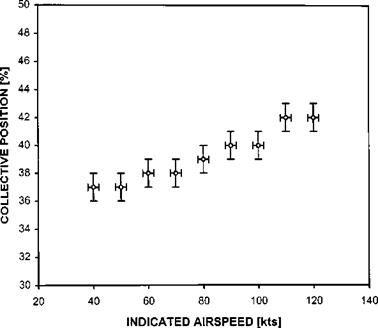Flight at constant torque
Flight at constant torque and in particular the collective position required to balance the forces and moments generated will give a clue to the rotor speed variation at differing airspeeds. If the helicopter is to fly at constant power, or torque, as airspeed is varied from the hover then it must adopt a rate of climb when the power for level flight at a given airspeed is less than hover power and a rate of descent when it is greater. The collective pitch required, for constant power, will depend on the thrust required to balance the weight, the vertical and horizontal drag and the degree to which compressibility and blade stall have affected the aerodynamic performance of the rotor. In general as the airspeed increases the drag penalty increases thus increased thrust is required to maintain the force balance. Note that although above minimum power speed the rate of climb required for constant power will be less; the increase in horizontal drag with airspeed more than makes up for the reduction in vertical drag and a net increase in thrust is usually required. Provided the rotor aerodynamic performance is not degraded with airspeed it can be assumed that the variation in collective lever position will match the thrust requirement. Flight test data, Fig. 6.11, can be seen to support these theoretical results.
|
|
|
|













